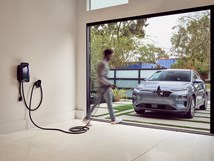GM Unveils Self-Driving Car with No Steering Wheel or Pedals
General Motors Co.’s Cruise AV is a production-ready car designed with no manual controls and built to operate autonomously.
General Motors Co.’s Cruise AV is a production-ready car designed with no manual controls and built to operate autonomously.
GM has asked the U.S. Dept. of Transportation for permission to begin testing the fourth-generation electric car on public roads in 2019. The company envisions users summoning one of the vehicles with a mobile app that also enables them to preset the car’s interior temperature and radio station settings before being picked up.
The Cruise AV lacks a steering wheel or foot pedals, but it otherwise resembles a conventional car inside with standard forward-facing seats. One key difference: The dashboard has none of the usual instruments. Instead, a center-mounted display screen sits atop a few manual controls for ventilation.
GM has equipped the Cruise AV with five laser sensors, multiple cameras and an array of short-range, long-range and articulating radars. The car is capable of checking its path 10 times per second, calculating multiple future paths simultaneously and anticipating the movement of nearby objects, according to the company.
Safety features include two main computers that operate simultaneously and act as backups for each other. The car also uses multiple methods of pinpointing the vehicle’s location. The steering and braking systems have redundant actuators, power sources and computerized controls.
The cars also will use “geo-fencing” techniques that restrict their operation to a geographic area. GM says the cars will operate only over roads for which it has high-definition mapping data and only under “known” operating conditions.
RELATED CONTENT
-
On Fuel Cells, Battery Enclosures, and Lucid Air
A skateboard for fuel cells, building a better battery enclosure, what ADAS does, a big engine for boats, the curious case of lean production, what drivers think, and why Lucid is remarkable
-
On Electric Pickups, Flying Taxis, and Auto Industry Transformation
Ford goes for vertical integration, DENSO and Honeywell take to the skies, how suppliers feel about their customers, how vehicle customers feel about shopping, and insights from a software exec
-
GM Develops a New Electrical Platform
GM engineers create a better electrical architecture that can handle the ever-increasing needs of vehicle systems








